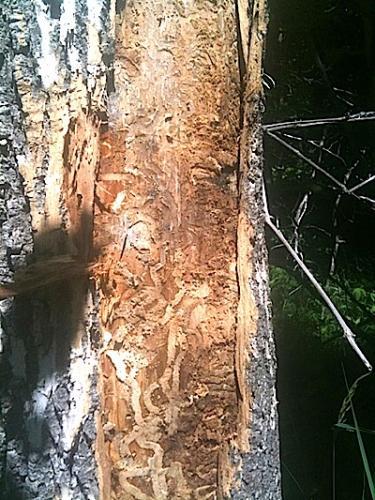A small insect that causes as much concern in the eastern United States as does the mountain pine beetle in the western half of the country has turned up in Sleeping Bear Dunes National Lakeshore, where it has infested some trees near Little Glen Lake.
The discovery of the Emerald Ash Borer in the lakeshore marks the first time it has been documented there. Lakeshore staff currently are working with partners and visitors to assess and mitigate the damage caused by these invasive pests.
Since the initial EAB discovery, Lakeshore staff have been working with the Michigan Department of Agriculture to assess its spread. It appears that up to 90 percent of the ash trees on the mainland in the Lakeshore might be infested, according to a park release. With the rapid rate at which the spread has occurred, all of the ash trees on the mainland in the Lakeshore are at imminent risk, park officials say. The highest level of known infestation occurs at the north end of the park in the Good Harbor area.
EAB was first discovered in the United States in Detroit in 2002; however, it is thought to have been introduced in the early 1990s in wooden packing material that originated in Asia.
Since its discovery in Detroit, EAB has been found in 13 states. Although the insects are only able to travel about one mile per year on their own, EAB has spread far more rapidly through transport of firewood. It is estimated that 80 percent of the infestations in Michigan are the result of firewood transport.
"The National Lakeshore is saddened by the news that this destructive insect has been found here. We are in the process of working with other agencies to explore our options for control, but the outlook for the ash trees is bleak," said Lakeshore Superintendent Dusty Shultz."
EAB kills all species of ash (Fraxinus spp.) found in Michigan by feeding on the cambium layer that transports nutrients in the tree. The feeding effectively girdles the tree, restricting nutrient transport and eventually killing the tree.
In addition to EAB, area forests are threatened by numerous other pests, including Asian longhorn beetles (affecting maples), beech bark disease, oak wilt, and hemlock woolly adelgid, according to park officials.
In an effort to slow or prevent the spread of forest pests, the Lakeshore instituted a partial firewood transport ban in its campgrounds in 2011, and plans to expand that to a full ban in 2012. All firewood used in the campgrounds would have to be purchased onsite from the Lakeshore's approved vendors, or collected by camping permit holders as dead and down wood within designated areas of the Lakeshore.




Comments
Sad news, but in Michigan it's been clear this was a matter of when, not if. The "Don't Move Firewood" campaign has been quite effective in getting the word out, but all it takes is one failure. Here's a link to a map of the extent of EAB in 2009: http://www.fs.fed.us/foresthealth/technology/images/PestRanges_eab.jpg
Like watching a slow-motion, unstoppable trainwreck.